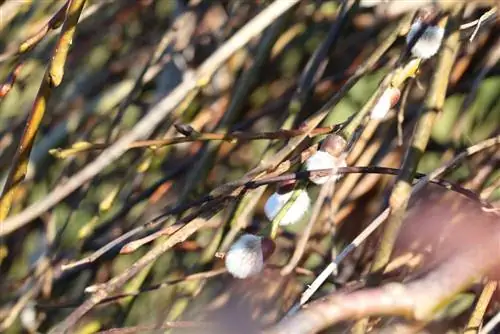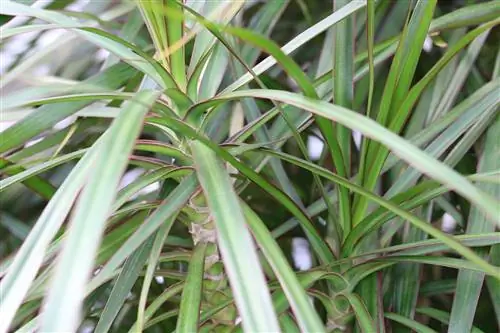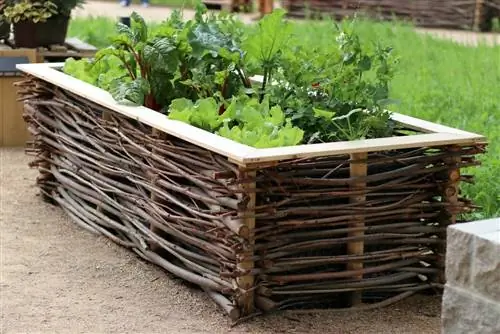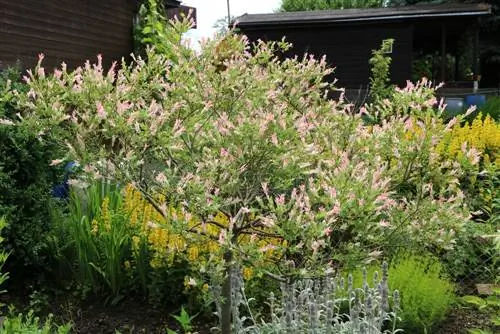- Author admin [email protected].
- Public 2023-12-17 03:39.
- Last modified 2025-01-24 12:45.
The dragon willow Salix udensis Sekka is often referred to as the Amur willow and grows as a small tree or 3-5 m high and wide shrub. Its reddish shoots have gray hairs when young. While the tops of the leaves are green and shiny, the undersides are more bluish green. The white, cup-shaped flowers of the dragon willow appear in March/April before the leaves emerge. This tree requires relatively warmth but is still hardy. The special thing about this plant is undoubtedly its flat, curled branches, which give it its name because they are reminiscent of dragon tails.
Site and soil conditions
This dragon willow, also known as the Japanese dragon willow, is very undemanding - this applies to both the location and the soil. Since it grows more in width than in height, it is important to ensure there is enough distance from other plants and also from neighboring properties. It thrives equally well in sunny and partially shaded locations. There is no need to pay particular attention to the nature of the soil, although it grows somewhat better on sandy soils. The flowers are usually more lush there. Compacted soils should be avoided as they tend to retain moisture. This in turn results in stunted growth and increases susceptibility to disease and pest infestation. The same applies to calcareous soils, which should be avoided as they can promote chlorosis. Otherwise, this plant is suitable for all moist, acidic to neutral and nutrient-rich soils. Sandy-loamy and gravelly-loamy substrates are tolerated just as well as sandy-clayey ones.
Tip:
When planting the dragon willow, you should make sure to choose a location where it can stay for many years, because it doesn't like changes or transplanting. If transplanting is unavoidable, this should only be done when temperatures are cooler, for example in October.
Care requirements
- Dragon willow places hardly any demands on care.
- She doesn't mind the heat or cold.
- Despite everything, you should water them regularly, especially if there is prolonged drought.
- Work some compost into the soil when planting.
- No further fertilization is necessary.
- This tree does not need winter protection, it is frost hardy.
- An important part of care is the cut.
- The dragon willow is very tolerant of cutting.
- Prune regularly, if necessary twice a year.
- If you don't cut it completely, it will only grow poorly.
- It responds to severe pruning with stronger growth.
- It also promotes the development of these bizarre deformations (verbal changes).
- These deformations are characteristic of this plant and its best ornament.
- The so-called verb changes are the result of genetic disorders.
- In other plants, such deformations can sometimes be attributed to viruses.
- Remove dead plant parts every time you prune.
Tip:
In older specimens, small black bumps can form on both twigs and branches, which should always be cut out if possible.
Propagation exclusively vegetatively
The dragon willow can only be propagated vegetatively, i.e. through cuttings. In contrast to cuttings, which are half woody and leafy, cuttings are leafless, woody pieces of shoots, ideally from shoots from the previous year. These are cut during the vegetation break in autumn or winter, for example when thinning the dragon willow or during regular pruning in winter. The cuttings should be about 20 cm long and, as already mentioned, leafless. However, they should have 4-5 buds (eyes). They are then inserted so deep into a mixture of equal parts garden soil and sand that only the top eye sticks out of the substrate. The roots then form from the buds that lie underground. Rooting in a glass of water is also possible, but this takes a long time and is not always successful. In mild winters, the cuttings can be stuck directly into the ground in the garden after cutting. If you want to make sure that they survive the winter undamaged, you should grow them in pots indoors and plant them outside in the garden in the spring when they are well rooted. It is more advisable to grow them indoors, because the cooler it is, the longer it takes for them to form roots or grow. During this time, the substrate should always be evenly moist and not dry out. So that the cutting does not just form roots, but also several shoots right from the start, it is advisable that the cutting is cut both at the top and bottom, i.e. it has two cutting surfaces. It is important to mark the top and bottom ends so that the cutting wood goes into the ground the right way round. It's best to cut diagonally at the bottom and straight at the top. Ideally, the interface should always be opposite one eye.
Tip:
In order to achieve optimal results, it is important to only cut the cuttings from he althy and strong shoots. In addition, cuttings should always be cut from one-year-old wood and not from older wood, as these have difficulty or no roots at all.
Disease and pest infestation
Dragon willows can be attacked by, among other things,fungal diseasessuch aswillow anthracnose. The willow anthracnose is shown by brown leaf spots and scab-like, black-brown bark on two-year-old shoots or completely black-brown one-year-old shoots. To combat this, you can cut back heavily into he althy wood or treat it with appropriate fungicides. There is also a risk ofpest infestationcaused by thewillow leaf beetleor thewillow borer The willow leaf beetle is a small, silvery, shiny one red, blue or spotted beetle that eats holes in leaves. Control is usually not necessary. If necessary, preparations can be used specifically against leaf beetles on ornamental trees. An initial infestation with the willow borer, a moth and its larvae, quickly becomes severe, as the species-typical smell of these pests attracts more and more females. This results in a heavy infestation with the larvae of this butterfly (caterpillars), which damage the wood at different ages. If the infestation is detected early, it can be treated with a systemic insecticide. Later, the only thing that helps is felling or clearing the tree and its roots.
Conclusion
The dragon willow is not often found in home gardens, but where it is, it becomes a real eye-catcher, especially in winter. Their bizarrely shaped branches are not only very decorative in the garden, but are also very beautiful to look at in dried bouquets or arrangements. It is suitable for large and small gardens and is also very easy to care for.






